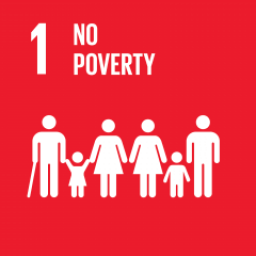SDG 1 - No Poverty

End poverty in all its forms everywhere.
Poverty in the Pacific is focused on hardship and lack of economic opportunity and social exclusion. While food and extreme poverty remains relatively low, an estimated one in four Pacific islanders are likely to be living below their country’s basic-needs poverty line (BNPL). Children are especially vulnerable to poverty and inequality because of their dependency on adults for care and protection, and for food. Deprivation and lost opportunities in childhood can have detrimental effects that may persist throughout a child’s life. If a child does not receive adequate nutrition, stunting may result, and intellectual development may be impaired. Poorly nourished children are more vulnerable to disease, tend to perform worse in school, and less likely to be productive adults.
By 2030, eradicate extreme poverty for all people everywhere, currently measured as people living on less than $1.25 a day
Indicator 1.1.1: Proportion of population below the international poverty line, by sex, age, employment status and geographical location (urban/rural)
By 2030, reduce at least by half the proportion of men, women and children of all ages living in poverty in all its dimensions according to national definitions
Indicator 1.2.1: Proportion of population living below the national poverty line, by sex and age
![]() Download Metadata for indicator 1.2.1
Download Metadata for indicator 1.2.1
Indicator 1.2.2: Proportion of men, women and children of all ages living in poverty in all its dimensions according to national definitions.
Visualisation(s) not yet available
View 1.2.2 data on PDH.stat
Implement nationally appropriate social protection systems and measures for all, including floors, and by 2030 achieve substantial coverage of the poor and the vulnerable
Indicator 1.3.1: Proportion of population covered by social protection floors/systems, by sex, distinguishing children, unemployed persons, older persons, persons with disabilities, pregnant women, newborns, work-injury victims and the poor and the vulnerable
By 2030, ensure that all men and women, in particular the poor and the vulnerable, have equal rights to economic resources, as well as access to basic services, ownership and control over land and other forms of property, inheritance, natural resources, appropriate new technology and financial services, including microfinance
Indicator 1.4.1: Proportion of population living in households with access to basic services
![]() Download Metadata for indicator 1.4.1
Download Metadata for indicator 1.4.1
Indicator 1.4.2: Proportion of total adult population with secure tenure rights to land, with legally recognized documentation and who perceive their rights to land as secure, by sex and by type of tenure
NOTE: this indicator is not one of the 132 indicators in the Pacific SDG indicator subset
By 2030, build the resilience of the poor and those in vulnerable situations and reduce their exposure and vulnerability to climate-related extreme events and other economic, social and environmental shocks and disasters
Indicator 1.5.1: Number of deaths, missing persons and persons affected by disaster per 100,000 people
NOTE: this is a repeat of indicator 11.5.1 which is one of the 132 indicators in the Pacific SDG indicator subset
Indicator 1.5.2: Direct disaster economic loss in relation to global gross domestic product (GDP)
NOTE: this is a repeat of indicator 11.5.2 which is one of the 132 indicators in the Pacific SDG indicator subset
Indicator 1.5.3: Number of countries with national and local disaster risk reduction strategies
NOTE: this is a repeat of indicator 13.1.2 which is one of the 132 indicators in the Pacific SDG indicator subset
Ensure significant mobilization of resources from a variety of sources, including through enhanced development cooperation, in order to provide adequate and predictable means for developing countries, in particular least developed countries, to implement programmes and policies to end poverty in all its dimensions
Indicator 1.A.1: Total official development assistance grants from all donors that focus on poverty reduction as a share of the recipient country’s gross national income
NOTE: this indicator is not one of the 132 indicators in the Pacific SDG indicator subset
Indicator 1.A.2: Proportion of total government spending on essential services (education, health and social protection)
NOTE: this indicator is not one of the 132 indicators in the Pacific SDG indicator subset
Create sound policy frameworks at the national, regional and international levels, based on pro-poor and gender-sensitive development strategies, to support accelerated investment in poverty eradication actions
Indicator 1.A.1: Pro-poor public social spending
NOTE: this indicator is not one of the 132 indicators in the Pacific SDG indicator subset